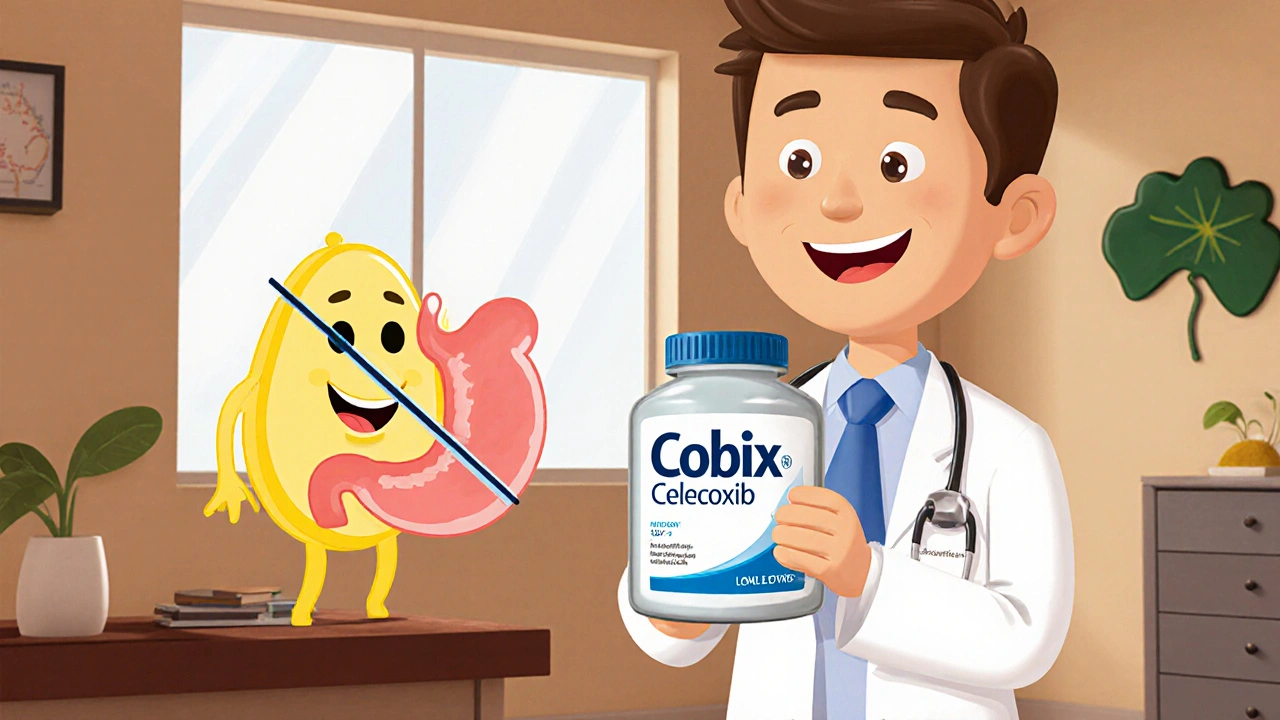
Pain Reliever Risk Assessment Tool
Find the safest pain relief for you
Answer a few questions about your medical history to see which pain relievers are safest for your specific situation.
Your Health Profile
When it comes to tackling inflammation and arthritis pain, many Australians reach for Cobix (Celecoxib) - a prescription‑only COX‑2 inhibitor that promises strong relief with fewer stomach issues than traditional NSAIDs. But is it the best fit for you? And what other pills sit on the market that might be safer, cheaper, or simply work better for your condition? This guide breaks down Cobix side‑by‑side with the most common alternatives, highlighting dosage, risks, and real‑world usage so you can make a confident choice.
How Cobix Works and Who It’s Made For
Celecoxib belongs to the class of drugs called COX‑2 selective non‑steroidal anti‑inflammatory drugs (NSAIDs). By blocking the COX‑2 enzyme, it reduces prostaglandin production - the chemical that fuels pain and swelling - without heavily affecting COX‑1, which protects the stomach lining. Because of this selectivity, doctors often prescribe Cobix for osteoarthritis, rheumatoid arthritis, and acute pain when patients have a history of gastrointestinal (GI) irritation. Typical adult dosing is 100-200 mg once daily, sometimes split into 200 mg twice daily for severe flare‑ups. The drug is taken with food to improve absorption and minimize any lingering stomach upset.
Key Factors to Compare Across Pain Relievers
Before diving into the drug‑by‑drug rundown, let’s outline the criteria that matter most when you’re weighing options:
- Drug class: COX‑2 inhibitor, non‑selective NSAID, or non‑NSAID analgesic.
- Prescription status: Requires a doctor’s script or available over‑the‑counter (OTC).
- GI risk: Likelihood of causing ulcers, bleeding, or dyspepsia.
- Cardiovascular (CV) risk: Potential to raise blood pressure, trigger clotting events, or affect heart health.
- Typical dose & frequency: How often you need to take it.
- Common indications: The conditions where the drug shines.
Comparison Table: Cobix and Its Main Rivals
| Drug | Class | Typical Adult Dose | Prescription? | GI Risk | CV Risk | Common Uses |
|---|---|---|---|---|---|---|
| Cobix (Celecoxib) | COX‑2 selective NSAID | 100‑200 mg once daily | Yes | Low | Moderate (may raise BP) | OA, RA, acute pain |
| Ibuprofen | Non‑selective NSAID | 200‑400 mg every 4‑6 h | No (OTC up to 1200 mg) | Medium‑High | Low‑Moderate | Headache, mild arthritis |
| Naproxen | Non‑selective NSAID | 250‑500 mg twice daily | OTC (lower dose) / Rx (higher) | Medium | Moderate‑High | Chronic inflammatory pain |
| Meloxicam | COX‑2 preferential NSAID | 7.5‑15 mg once daily | Yes | Low‑Medium | Moderate | OA, RA |
| Etoricoxib | COX‑2 selective NSAID | 30‑120 mg once daily | Yes (Australia) | Low | High (thrombotic risk) | OA, gout flares |
| Acetaminophen (Paracetamol) | Analgesic/Antipyretic (non‑NSAID) | 500‑1000 mg every 4‑6 h | No (OTC) | Very Low | None | Mild to moderate pain, fever |
| Tramadol | Weak opioid | 50‑100 mg every 4‑6 h | Yes | Low | Low‑Moderate (dependence risk) | Severe pain when NSAIDs insufficient |
When Cobix Shines: Ideal Scenarios
If you’ve had stomach ulcers from ibuprofen or naproxen, Cobix’s low‑GI profile can be a game‑changer. Its once‑daily dosing also suits people who forget multiple daily pills. For moderate‑to‑severe arthritis pain that hasn’t responded to OTC NSAIDs, many rheumatologists start patients on 100 mg and titrate up, monitoring blood pressure along the way.
However, the drug isn’t a free‑pass. It carries a moderate cardiovascular risk, especially in patients with hypertension, high cholesterol, or a history of heart attack. In those cases, doctors may lean toward non‑COX‑2 options with a better CV track record, such as low‑dose aspirin (for heart protection) combined with a GI‑sparing NSAID.
Alternatives That Might Suit You Better
Celecoxib alternatives fall into three buckets: non‑selective NSAIDs, other COX‑2 inhibitors, and non‑NSAID pain relievers. Below we unpack when each group wins.
1. Non‑Selective NSAIDs (Ibuprofen, Naproxen, Diclofenac)
These are the workhorses of over‑the‑counter pain relief. Ibuprofen (e.g., Nurofen) is cheap, widely available, and effective for headaches, menstrual cramps, and mild arthritis. Naproxen’s longer half‑life (≈12 h) means you can take it twice a day instead of three to four times, which some users prefer for chronic pain. Diclofenac (often a topical gel in Australia) offers targeted relief with fewer systemic side effects.
The trade‑off is GI irritation - up to 20 % of regular users develop dyspepsia or ulcers. If you combine these NSAIDs with a proton‑pump inhibitor (PPI) like omeprazole, you can blunt the stomach damage, but you still face a modest CV risk.
2. Other COX‑2 Inhibitors (Meloxicam, Etoricoxib)
Meloxicam sits somewhere between a classic NSAID and a COX‑2 selective drug. Its daily dose is tiny (7.5 mg), making it convenient. Studies suggest its GI risk is comparable to Celecoxib, while its CV risk is slightly lower, though still present.
Etoricoxib, approved in Australia under the brand Arcoxia, delivers potent inflammation control at 30‑120 mg once daily. It’s often chosen for gout attacks. The catch? Regulatory agencies have flagged higher thrombotic events, so it’s reserved for patients without major heart disease.
3. Non‑NSAID Analgesics (Acetaminophen, Tramadol)
Acetaminophen is the safest first‑line option for mild to moderate pain, especially when you can’t tolerate any NSAID. It has no GI or CV impact but does carry a liver toxicity risk at doses >4 g per day or in patients with chronic alcohol use.
Tramadol enters the scene when NSAIDs and acetaminophen fall short. It works on opioid receptors and also inhibits serotonin reuptake. While effective for severe pain, it can cause dizziness, nausea, and has a dependence potential, so it’s prescribed for short courses only.
Side‑Effect Spotlight: What to Watch For
Every medication has a profile. Here’s a concise checklist you can print and keep beside your meds:
- Stomach pain, black stools: Stop the drug and call your GP - could be ulcer bleeding.
- Sudden swelling of legs or chest pain: May signal a clot; seek emergency care.
- Elevated blood pressure: Monitor weekly; your doctor might adjust the dose or switch drugs.
- Kidney changes (reduced urine, swelling): Particularly relevant for high‑dose NSAIDs; hydrate well.
- Liver enzymes (acetaminophen overload): Avoid alcohol, keep total daily acetaminophen under 3 g.

How to Choose the Right Option for You
- Identify your primary concern: Is GI safety the top priority? Or are you more worried about heart health?
- Check your medical history: Existing ulcer disease, hypertension, or heart disease will tip the scales.
- Consider cost and access: OTC options like ibuprofen are cheap, while prescription COX‑2 inhibitors may be subsidised under the PBS in Australia.
- Trial under medical supervision: Start at the lowest dose, track pain relief and side effects for two weeks before deciding.
- Re‑evaluate regularly: Pain levels change; so can your risk profile.
Talking openly with your GP about these points will lead to a tailored plan that balances effectiveness and safety.
Quick Tips for Managing Pain Without Over‑Reliance on Medication
- Apply heat or cold packs for 15‑20 minutes a few times daily.
- Engage in low‑impact exercise (swimming, walking) to keep joints mobile.
- Maintain a healthy weight - less load on knees and hips reduces inflammation.
- Consider physiotherapy or acupuncture for targeted relief.
- Stay hydrated; dehydration can worsen joint pain.
Frequently Asked Questions
Can I switch from Cobix to an over‑the‑counter NSAID?
Yes, but do it under a doctor’s guidance. If you’ve had GI issues, moving to ibuprofen may increase ulcer risk. Often a taper-reducing Cobix dose while introducing a low‑dose OTC NSAID-helps your body adjust.
Is Cobix safe for people with high blood pressure?
Cobix can raise systolic pressure by a few points in some patients. If you have uncontrolled hypertension, your GP may prefer a non‑COX‑2 NSAID with a PPI or suggest acetaminophen as first‑line.
How does the effectiveness of Meloxicam compare to Cobix?
Both drugs reduce inflammation, but studies show Meloxicam’s pain relief is roughly equivalent for osteoarthritis, with a slightly higher GI risk than Cobix but marginally lower cardiovascular risk.
What should I do if I miss a dose of Cobix?
Take the missed tablet as soon as you remember, unless it’s almost time for the next dose. In that case, skip the missed one-don’t double up.
Are there natural alternatives to Celecoxib?
Turmeric (curcumin), omega‑3 fatty acids, and ginger have modest anti‑inflammatory effects. They can complement, but not replace, prescription meds for moderate‑to‑severe arthritis. Always discuss supplements with your doctor to avoid interactions.
Choosing the right pain reliever is a balance of efficacy, safety, and personal circumstance. Whether you stay on Cobix, switch to ibuprofen, or add a non‑NSAID option, the key is informed decision‑making backed by your doctor’s counsel.







Thank you for the comprehensive overview of Celecoxib and its alternatives. The structured comparison table is especially helpful for patients attempting to weigh gastrointestinal versus cardiovascular risks. It is prudent to emphasize that individual risk profiles-such as a history of ulcer disease or hypertension-should guide the selection of therapy. Moreover, integrating non‑pharmacologic strategies, as you outlined, can reduce reliance on medication alone. I encourage readers to discuss these nuances with their prescriber to tailor an optimal regimen.
Honestly, if you’re still debating over OTC ibuprofen versus a prescription, you’re missing the point 🙄. Celecoxib is a flagship drug, and anyone who chooses cheap painkillers over it is just being reckless. 🇺🇸💪
We all feel the sting of arthritis, yet we must act with resolve. Choose the drug that won't betray your stomach. Let the heart risk be a whisper, not a shout.
Indeed, the balance between inflammation and vitality mirrors the ancient Tao – a middle path that honors both body and spirit. 🌿 Embracing a measured dose of Celecoxib can harmonize that equilibrium, while vigilant monitoring ensures the heart remains steady.
Hello!!! I must say, the content presented herein is quite exhaustive; however, one might consider that the pharmacological discourse could have benefited from a deeper dive into the metabolic pathways-particularly the cytochrome P450 interactions!!! Nonetheless, kudos for the effort!!!
Thank you for highlighting the metabolic considerations. A thorough understanding of CYP2C9 involvement indeed enhances prescriber confidence, especially when patients are on concomitant anticoagulants. 😊 Should you require additional resources on drug‑drug interactions, I am happy to compile a brief dossier.
The analysis of non‑selective NSAIDs versus COX‑2 selective agents raises an essential point about cost‑effectiveness, especially within the Australian PBS framework. While ibuprofen and naproxen are undeniably affordable, their cumulative gastrointestinal burden can translate into higher long‑term expenses when ulcer complications arise. Conversely, Celecoxib’s higher upfront price may be offset by reduced need for proton‑pump inhibitors and fewer hospitalizations. Therefore, clinicians should adopt a holistic economic perspective rather than focusing solely on drug acquisition costs.